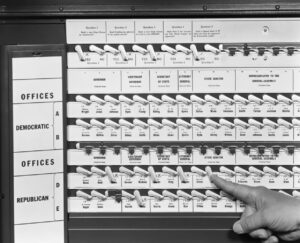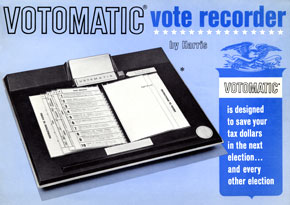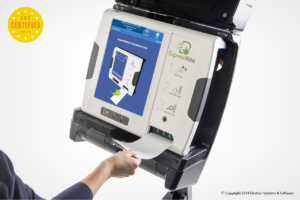With the 2020 election soon upon us, some people are already filling out their absentee ballot or simply waiting until election day. What most people don’t know is the progress that these voting machines have made over the years.

An undated photo of a lever voting machine.
The first lever-operated voting machine was created by Jacob H. Myers and Andrew J. Gillespie with its first public use in an 1892 Lockport, New York local election. The inner workings of the machine are self-explanatory. Every candidate in each race had their own lever, which could be pulled by the voter, as well as an option to vote by party.
In 2001, computer science professor at the University of Iowa, Douglas Jones, thoroughly researched the history of voting and wrote A Brief Illustrated History of Voting. In his writings, he noted the downsides to the mechanism.
“Unfortunately, the mechanism of a lever voting machine maintains no independent record of each voter’s ballot,” he said. “Instead, the only record of a vote is the count maintained on the mechanical register behind each voting lever, where each register has a mechanism comparable to the odometer in a car. Not only is this vulnerable to tampering by the technicians who maintain the machine, but it means that the machine has an immense number of moving parts that are subject to wear and very difficult to completely test.”
An alternative to the lever-operated system was the punch cards. These cards were developed by the International Business Machines Corporation (IBM). In the 1960s, Joseph P. Harris and William Rouverol, professors from the University of California at Berkeley, transformed these cards specifically for voting. They dubbed this the Votomatic.
“The Votomatic ballot is pre-scored at each voting position so that punching with a stylus through that position into an appropriate backing will remove a rectangle of chad, leaving a hole that is counted as a vote,” Jones said. “The backing used inside the Votomatic machine is a complex structure of elastomeric strips, and the stylus has a relatively comfortable handle on it. When used for absentee voting, a disposable styrofoam sheet is generally used as backing, and in some jurisdictions, the stylus for absentee ballots is an unbent paperclip.”
This process allowed computers to tally votes and made the results of elections known much quicker. However, the positioning of chads was a major setback to this system, most notably in the 2000 United States presidential election.
Soon after, states decided to simplify the process and had voters make their selections by having them fill in the bubble of their preferred candidate on a slip of paper, which would later be computer by optical scanning technology, similar to how standardized tests are conducted. This made mail-in voting possible, which in return made voting easier.
Since then, there have been various models of direct recording electronic voting machines.

ExpressVote. Courtesy of Lisa Lovedahl
For the 2020 general elections, what we’ll see is much different. Jackson County Board of Elections Director Lisa Lovedahl described the ongoing changes in North Carolina.
“We have new equipment,” she said. “In 2016, we used the iVos direct record touch screen voting machines. That equipment was de-certified by North Carolina and new paper-based equipment had to be purchased this year. We still use a touchscreen ballot marking device that provides ADA compliance while closely resembling the equipment that Jackson County voters are familiar with. Jackson County did not have any issues with the previous voting system, but the equipment was coming to its end of life stage and was not paper-based.”
More information on voting equipment and how to vote in North Carolina can be found at ncsbe.gov.






